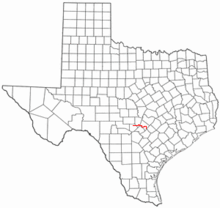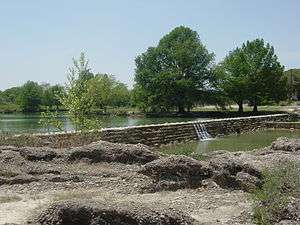Blanco River (Texas)
| Blanco River | |
|---|---|
 Location of the Blanco River in central Texas | |
| Country | U.S.A. |
| Basin | |
| Main source |
Kendall County, Texas, U.S.A 1,607 feet (490 m) |
| River mouth | San Marcos River, Hays County, Texas, U.S.A. |
| Basin size | 412 square miles (1,067 km2) |
| Physical characteristics | |
| Length | 87 miles (140 km) |
| Discharge |
|

The Blanco River is a river in the Hill Country of Texas in the United States.
Course
The primary source for the river is a series of springs in northern Kendall County. The river flows generally eastward for 87 miles (140 km) through Kendall County, Blanco County and Hays County. Near San Marcos, it takes a southerly turn and joins with the San Marcos River.
The river is generally quite shallow, and it briefly dips below ground in some areas in the Hill Country. As with many of the rivers in the Texas Hill Country, there is great variability in the Blanco River's flow. The mean flow is 93 ft³/s (3 m³/s), but heavy rains in the river's watershed can cause flash flooding with little warning.
2015 Flooding
In 1998, the Blanco River had peak flooding discharge of 2,970 cubic metres per second (105,000 cu ft/s) from a 1,067 square kilometres (412 sq mi) basin.[1]
Early in the morning on May 24, during the 2015 Texas–Oklahoma floods, the Blanco River experienced catastrophic flooding. The river at Wimberley rose more than 30 feet in less than three hours, and set a new record high crest of more than 40 feet while disabling the gauge.
Rainfall totals of 10 to 13 inches were reported upstream in southern Blanco County, and all of this water entered the Blanco River and Little Blanco River. The Fischer Store Rd. bridge over the Blanco River was destroyed by flood waters west of Wimberley. The Blanco River, down stream from the bridge, at Wimberley reached a record crest. The gauge failed at 40 feet and the USGS later estimated the crest at 44.9 feet with peak flow of 175,000 cubic feet per second (5,000 m3/s). This height was more than 10 feet over the previous record height of 33.3 feet from 1929. Homes along the banks of the Blanco River from the City of Blanco, through Wimberley, and down to San Marcos experienced an historic flood. Many homes were totally destroyed and swept down stream. Many homes were struck by large debris, including full size cypress trees which typically lined the banks of the river. A house in the 100 block of Deer Crossing Ln. in Wimberley was washed away in the flood with nine people inside. There was one lone survivor while eight others died. Six bodies were recovered and the two small children remain missing. Several of the bodies were recovered near San Marcos, Texas nearly 30 miles downstream. Ten fatalities were reported for this event. The river experienced rises that exceeded 20 feet in one hour. Estimates of insured losses are around $100 million. Overall in Hays County, including Wimberley and San Marcos, 321 homes were destroyed, with hundreds more heavily damaged.[2]
During the May 24 event, the river crested at 36.52 ft at Kyle, Texas, which was (at the time) the highest the river had been since a 40.0 ft crest in 1929.[3] Kyle is downstream of the Waverly gauge.
On October 30, 2015, the river flooded again. The river crested at 37.24 ft at Kyle,[3] exceeding the gauge height of the May 24, 2015 crest, becoming the highest the river had been since a 40.0 ft crest in 1929. The Waverly gauge had a crest of only 26.54 ft on October 30, 2015. Flooding near San Marcos culminated in the closure of the Interstate 35 bridge over the Blanco River for the second time in 2015.[4]
Geography
The upper reaches of the Blanco River are hilly, and the river's slopes are frequently steep. As the river reaches the Balcones Escarpment near San Marcos, it widens and its slopes moderate; this is typical of rivers in the central part of the state.
Economy
The Blanco River provides drinking water for the city of Blanco, as well as water supplies for nearby ranches. The river also supports a number of recreational areas, including the Blanco State Recreation Area in Blanco, the Boy Scouts camp El Rancho Cima near Wimberley, and other private parks and resorts.
See also
References
- ↑ Richard A. Earl (2007). "The October 1998 flood of the upper Guadalupe River system, Central Texas". Texas State University.
- ↑ http://www.ncdc.noaa.gov/stormevents/eventdetails.jsp?id=581658
- 1 2 http://water.weather.gov/ahps2/hydrograph.php?wfo=ewx&gage=kyet2
- ↑ http://www.statesman.com/news/news/transportation/rains-caused-metrorail-suspension-bus-reroutes-176/npCST/
External links
- Blanco River from the Handbook of Texas Online
- The Narrows (of the Blanco River) from the Handbook of Texas Online
- Pull: Texas Canoe trip Video of a canoe trip down the river with winching.
- USGS WaterData: Stream Gauge Blanco River at Wimberly
- USGS WaterData: Stream Gauge Blanco River near Kyle